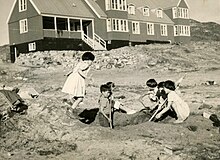Little Danes experiment
Following World War II, Danish government officials and non-governmental organisations believed Greenlandic society was underdeveloped, and sought to redesign it.
[4] With the selections made, the MS Disko departed Nuuk in May 1951 carrying 22 Greenlandic Inuit children:[5] thirteen boys and nine girls.
[A][8] After being moved to a so-called holiday camp at Fedgaarden,[B] operated by Save the Children,[4] they were immediately placed in quarantine over fears they carried contagious diseases.
[4] They were supposed to be sent back to Nuuk after about six months, but the construction of the orphanage by the program stalled, and over the course of their yearlong stay in Denmark, six of them were adopted by Danish families.
[14] In 2009, the prime minister of Greenland, Kuupik Kleist, demanded an apology from the Danish government, saying the experiment is a "classic colonial case".
[16] The same demand was also made by the Social Democrats of Denmark, calling it a "black chapter" for the nation, alongside requests for an investigating commission of the experiment.
[23] The next year, after waiting for the commission's report, the government of Denmark and its prime minister, Mette Frederiksen, officially apologised for the little Danes experiment.
[27] In March 2022, the government announced that the six surviving experiment members will receive a face-to-face apology from the prime minister and their requested compensation of 250,000 kroner;[28] Frederiksen traveled to Nuuk to apologise in a speech.

